Diverse work environments benefit scientific progress and the well-being of individual researchers - yet the geosciences are still lagging behind. Together with her contributors, Michelle Guitard reports on the current situation in the US, and suggests some ways in which underrepresented voices can be amplified
Guitard, M., Amplified voices: How identity shapes our scientific experience. Geoscientist
30 (1), 10-15, 2020
https://doi.org/doi: 10.1144/geosci2020-065,
Download the pdf here
The first time I heard about the Society for the Advancement of Chicanos/Hispanics and Native Americans in Science (SACNAS) I was reading a geological society’s monthly bulletin. The article summarized the lack of diversity in geoscience professions and included SACNAS as an organization dedicated to fostering success for the above-mentioned groups. I immediately logged on to the SACNAS website and enrolled as a student member. I remember feeling happy and excited. Here was a scientific community that intersected my cultural identity, made up of members with shared experiences, but also those from whom I could learn new scientific and cultural perspectives.
Anyone who has found the intersection between culture and career in a single organization can relate. But despite our best efforts in the geoscience community, this intersection is still hard to come by for geoscientists who belong to an underrepresented racial/ethnic group, or those who identify as LGBTQ+ and/or disabled. As a multi-faceted collection of sub-fields dedicated to understanding Earth, the geosciences’ greatest strength is diversity of thought. Yet one of its greatest weaknesses, workplace diversity, is surely limiting our progress. A recent assessment of geoscience PhDs awarded to United States citizens and permanent residents at US institutions found that the proportion of degrees granted to underrepresented minorities (American Indian/Alaska Native, Black/African American, and Hispanic/Latinx groups) had remained stagnant, even while the number of geoscience PhDs earned and the US minority population had both risen over the last four decades (Bernard & Cooperdock, Nature Geoscience, 2018). The inability of geoscience programs to recruit and retain underrepresented scholars may have consequences for scientific progress, as there are measurable benefits to diverse laboratories, including greater collaboration and more impactful science (AlShebli et al., Nature Communications, 2018).
Besides the broader scientific implications, workplace diversity may also affect the well-being of individual researchers. In a study of workplace satisfaction among lesbian, gay, bisexual, transgender and queer people (LGBTQ+) working in a science, technology, engineering, and mathematics (STEM) field within a US federal agency, LGBTQ+ employees reported lower workplace satisfaction compared to their non-LGBTQ+ counterparts; the population of LGBTQ+ employees surveyed was underrepresented compared to the US population (Cech & Pham, Social Sciences, 2017). Furthermore, STEM inclusion may be hindered by an individual’s perception that a STEM career is not a viable option, as demonstrated by students with mobility impairments, who were less likely to report STEM career aspirations compared to students without mobility impairments (Burgstahler & Chang, Review of Disability Studies, 2009).
Issues surrounding diversity, equity, and inclusion can arise because certain identities are at odds with the dominant STEM research culture, which often discounts personal identity in pursuit of scientific objectivity (Mattheis et al., Journal of Homosexuality, 2019). If this is the case, can we address these issues by reframing identity (e.g., cultural background, sexual orientation) as a lens through which we view scientific truth? Below are some insights and recommendations from geoscientists who identify as members of an underrepresented racial/ethnic group, as disabled and as LGBTQ+. This article aims to: 1) provide resources for those who identify with the above-mentioned groups, 2) foster an understanding of the issues faced by researchers underrepresented in STEM fields, and 3) highlight the benefits of viewing research through the lens of personal experience.
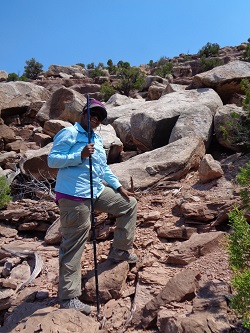 Dr. Claire Bailey
Dr. Claire Bailey
Image: Claire Bailey participates in a geologic survey in the southwestern United States
Claire is a recent graduate of the University of Texas at El Paso conducting research in sedimentology. On being a Black geoscientist, she says:
"I think about being Black in the geosciences, but I’m not sure if I’ve ever thought of what it means to be a Black geoscientist. I just recently started to think of myself as a geoscientist instead of someone who studies geoscience, which is weird considering I have three degrees in the subject. I think this speaks to how I battle with imposter syndrome; I know I’m not the only woman or black person or person who has this problem. Luckily, I have found a great group of friends and people with whom I can talk.
"To me, being a Black geoscientist means being a part of an amazing group of intelligent people who have faced similar struggles but keep moving forward, and who work to make the geoscience community feel more inclusive. I’ve been lucky that one of my first mentors in geoscience was a black woman who did so many cool things. Seeing her active in the community definitely inspired me to step out of my comfort zone and explore the world of geology."
Claire has found support in a number of societies and meetings:
"I think the number one society that supports Black geoscientists is the National Association of Black Geoscientists (NABG). NABG has a fall meeting every year with funding to support Black geoscience students from all over the country to come present their work. There are talks given by professionals from many different fields, including oil and gas, environmental, government, etc. This meeting has been a great place to network and meet other Black geoscientists. This community has been such a great space for me and other students to get advice and talk about what it is like to be a Black geoscientist. It is a space where I can connect with people who are at different stages within academia or in their careers. There is always someone who is willing to help you navigate a tough spot or search for great opportunities.
Becoming a more active member in NABG changed my life. The people I have met through this organization feel like family, and I feel so inspired by them. It’s cool to see people grow and change, and it just inspires me to continue to work hard and to work through tough situations. I know I have this great network of empowering people I can reach out to for advice. This past meeting, we had a keynote speaker, Stacy Lusk of Kuwait Energy, who gave the most inspiring keynote speech I have ever heard in my life. One of my favorite messages from her speech was, “You must decide, do you want to be liked or respected?” I think it inspired us to be who we are without fear."
Lydia Jennings
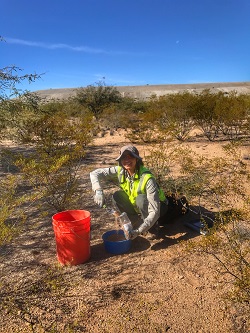 Image: Lydia Jennings collects soil samples for her PhD research c. Julie Neilson
Image: Lydia Jennings collects soil samples for her PhD research c. Julie Neilson
Lydia is a PhD candidate at the University of Arizona studying microbiology and soil science. She is a member of the Yaqui & Huichol tribes and is involved with a number of organizations and workshops that support Indigenous geoscientists and the integration of geoscience with Indigenous knowledge.
"In graduate school, I became involved in the American Indian Science and Engineering Society (AISES), which is a science organization and national conference geared towards helping Indigenous scientists develop their research and professional skills. AISES hosts workshops that feature scientists who are connecting traditional knowledge with standard scientific methods. The Geoscience Alliance also has powerful workshops that highlight Indigenous researchers and educators who bridge ways of knowing and recognize the cultural ceremony of research. There are talking circles to envision ways in which the geosciences can honor our cultural identity. We also share the challenges we experience within geosciences and how we can address those challenges. It’s a valuable place to brainstorm research projects, as well as a networking opportunity for graduate school and postdocs.
"These spaces recognize identity as a core asset of research, and that Indigenous geoscientists face unique issues. In one workshop I attended, people discussed their community’s observations of climate change. All groups mentioned traditional languages as a data source and as a place to identify solutions. This resonated with me because I am in the process of learning my own language. Language is inherent to who we are and understanding our cultural priorities, so I loved that it was recognized and respected among these scholars, especially because I have never felt supported in it before. I love that these organizations recognize that a person of color in science has to be trans-disciplinary. Not only do we need to know scientific theories but also the impacts of colonization, data translation, and higher education statistics. As Indigenous scientists, we have a responsibility to share our research with our community and advocate for those who follow us."
Lydia stresses the need for institutions to honor Indigenous data sources and contributions, which are steeped in rich scientific tradition yet fall outside the dominant scientific paradigm.
"Being part of an Indigenous geoscience community has helped me see my culture as an asset and grow my confidence as a researcher. My peers and I understand that our rich cultural heritages have an important legacy of knowledge; we recognize our communities have always been scientists. This has allowed me to think about how we can teach geoscience in a way that is inclusive of Indigenous scientific contributions, including recognizing when universities, cities, and public lands are on Indigenous lands, the importance of learning traditional place names, and supporting Indigenous land managers. We must also recognize that Indigenous scholarship includes being versed in dominant scientific thought, Indigenous studies, anthropology, sociology, and Indigenous language and culture."
Dr. Rocío Caballero-Gill
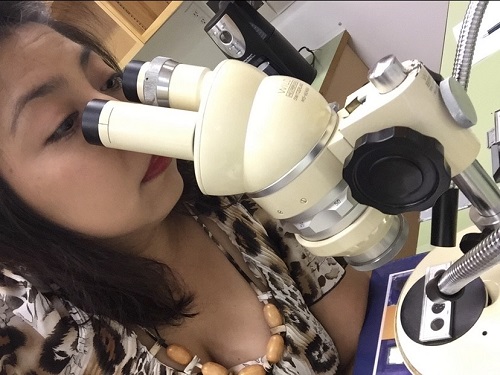 Image: Rocío Caballero-Gill analyses foraminifera under the microscope to get a paleoclimate perspective
Image: Rocío Caballero-Gill analyses foraminifera under the microscope to get a paleoclimate perspective
Rocío is a Postdoctoral Fellow at George Mason University working in paleoceanography and paleoclimatology. She tells us what it means to be part of the Latinx geoscience community.
"I feel I represent, not only myself or my family but also my community; it means I have both the honor and responsibility of knowing what I do and how I do it could be scrutinized even more. The scrutiny could come from the scientific community looking at me as Latina, or the Latinx community looking at me as a community representative. This is not a bad thing necessarily; I like constructive feedback to learn and better myself. It’s only bad when impostor syndrome sets in or when the criticism comes from a destructive, rather than constructive, place. Being Latinx in geoscience also means it opens up “familiar” doors. It doesn’t matter which country we come from, we have a special connection and I immediately want to know more about a scientist. Who are they? How can I support them?
"To have the support of fellow Latinx in geoscience feels like I have cheerleaders in my corner. It’s like an extended family, which is important because as Latinx we pride ourselves on the strength of our family ties. Being part of this community is empowering, gives me a boost of energy, and makes me feel more useful. In my experience, the sense of community and belonging can be critical to our path inside and outside of academia."
On the various organizations, groups, and meetings that support fellow Latinx in earth and planetary science, Rocío says:
"Emotional and financial support is critical to our success. It took me seventeen years to know more than a handful of Latinas in my field. Recently, two colleagues and I co-founded a group dedicated to inspiring, supporting, and empowering Latinas in geoscience and planetary science (GeoLatinas). We provide a space to accomplish great things by practicing leadership, teamwork, and mindfulness. We inspire and support each other; it’s like a big virtual family working together for our better present and future. Collaborators include: The Mars Society Chile, Society of Latinx/Hispanic Earth and Space Scientists, and more. Other organizations include: The Leadership Alliance, Pathways to Science, Latino STEM Alliance, Latinas in STEM, and Society for the Advancement of Chicanos/Hispanics and Native Americans."
Efforts focused on recruiting and retaining scientists from underrepresented racial and ethnic backgrounds were a critical first step toward diversity, equity, and inclusion in the geosciences. Increasingly, the discussion is broadening further. Here, two scientists share perspectives from the disabled and LGBTQ+ communities and provide feedback on efforts being made to increase representation for these groups.
Gabriela Serrato Marks
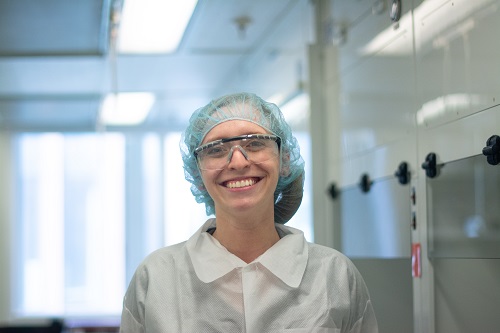 Image: Gabriela Serrato Marks getting ready to do some analytical laboratory work (c. Fatima Husain)
Image: Gabriela Serrato Marks getting ready to do some analytical laboratory work (c. Fatima Husain)
Gabriela is a PhD candidate in the Massachusetts Institute of Technology-Woods Hole Oceanographic Institute joint program specializing in paleoclimatology and geochronology. On navigating the geosciences with a disability and the importance of her community’s support, she says:
"It’s extremely frustrating when people assume that there is no way to make field trips accessible to disabled scientists. In reality, there are already plenty of STEM education and outreach activities by and for people with disabilities. One of my favorite organizations is the International Association for Geoscience Diversity (IAGD), a non-profit that advocates for disabled geoscientists. IAGD finally had a booth at the AGU Fall Meeting in 2018 despite being around for a long time. Another helpful organization/campaign is PhD Balance, which started as an Instagram account but has expanded to a full website where people can share their experiences with mental health and mental illness in academia. I have found a strong community online and now have friends with disabilities who are also graduate students with whom I can commiserate and celebrate with from afar. Connections like this are so important because they de-stigmatize disability to build a more welcoming community.
"The most important things I’ve learned since becoming part of the disabled community are the concepts of disabled pride and the social model of disability. Our bodies and minds are not the problem; deeply ingrained social barriers are the problem. There’s value in difference. We should embrace a wide variety of abilities and not stigmatize anyone. I’ve learned a lot from other disabled scientists who share their experiences publicly or privately. It’s powerful to realize that we have many a lot of common experiences, despite our different disabilities or health issues."
Dr. Benjamin Keisling
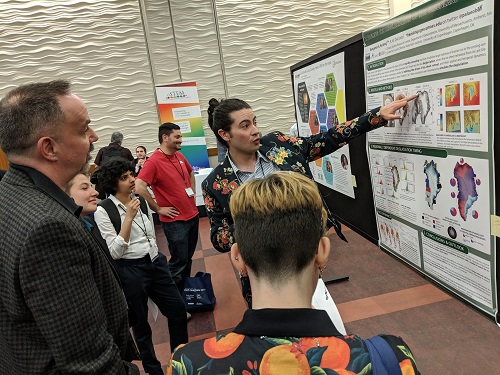 Image: Benjamin Keisling (center) presents his research at the Out in STEM annual conference c. Barbara Belmont, NOGLSTP
Image: Benjamin Keisling (center) presents his research at the Out in STEM annual conference c. Barbara Belmont, NOGLSTP
Benjamin is a Postdoctoral Fellow at Lamont-Doherty Earth Observatory studying glaciology and paleoclimatology. He shares what it means to have more visibility for LGBTQ+ scientists.
"I have rarely seen my queerness reflected in my role models. I often hear about other LGBTQ+ scientists through clandestine whisper networks and don’t feel free to discuss my personal life in professional spaces. In all the academic spaces I’ve inhabited, there has been little discussion about how queerness impacts science. Although there is a rich and complicated history of LGBTQ+ scientists’ contributions to STEM, a lot of it is still invisible.
"We still lack visible LGBTQ+ role models, and I’m afraid this will cause bright researchers to pursue careers in other realms. I know there are queer scientists who have never spoken publicly about what it means to be a queer scientist because of historical and personal circumstances. I think that’s a missed opportunity to encompass the full range of lived experiences of geoscientists. Being an LGBTQ+ geoscientist means advocating for members of the LGBTQ+ community who are still excluded, especially queer and transgender people of color."
On organizations that support LGBTQ+ scientists and the need for continued support by the broader community, he says:
"The professional society National Organization of Gay and Lesbian Scientists and Technical Professionals hosts national meetings, workshops at conferences, and a summit every other year. The organization Out in STEM has chapters all over the US and a few internationally as well. Another resource is 500 Queer Scientists. I’ll add the American Geophysical Union (AGU) to the list, too; since the 1980s, LGBTQ+ people at the AGU Fall Meeting have met up informally to network. The 2019 AGU Fall Meeting hosted an event or activity every day of the conference where LGBTQ+ geoscientists could gather.
There are lots of ways individuals can show support for LGBTQ+ geoscientists and encourage their professional organizations to do the same. In 2018, grassroots efforts to add pronouns to nametags accelerated AGU’s own efforts to be more inclusive in that respect. However, we still have a long way to go; for example, having enough accessible gender-neutral bathrooms at meetings needs to be a future priority."
A shift in thought
A diverse set of perspectives is critical to elevating the geoscience community, but perspective extends beyond one’s ethnic background or gender identity. It comes from our natural curiosity, our sense of duty to a community, and our concern for the planet. Who we are informs how we conduct ourselves in science; a scientist’s perspective cannot exist without their culture, their values, or their abilities. Perhaps with this shift in thought, we can broaden our thinking and increase our problem-solving abilities to ultimately benefit our research and society.
Michelle Guitard is a PhD candidate at the University of South Florida, College of Marine Science
References
AlShebli, B. K. et al. (2018) The preeminence of ethnic diversity in scientific collaboration. Nature Communications 9, doi:10.1038/s41467-018-07634-8.
Bernard. R. E. & Cooperdock, E. H. G. (2018) No progress on diversity in 40 years. Nature Geoscience 11, 292-295.
Burgstahler, S. & Chang, C. (2009) Promising interventions for promoting STEM fields to students who have disabilities. Review of Disability Studies 5, 29-47.
Cech, E. & Pham, M. V. (2017) Queer in STEM organizations: Workplace disadvantages for LGBT employees in STEM related federal agencies. Social Sciences 6, doi:10.3390/socsci6010012.
Mattheis, A. et al. (2019) A model of Queer STEM identity in the workplace. Journal of Homosexuality doi:10.1080/00918369.2019.1610632.